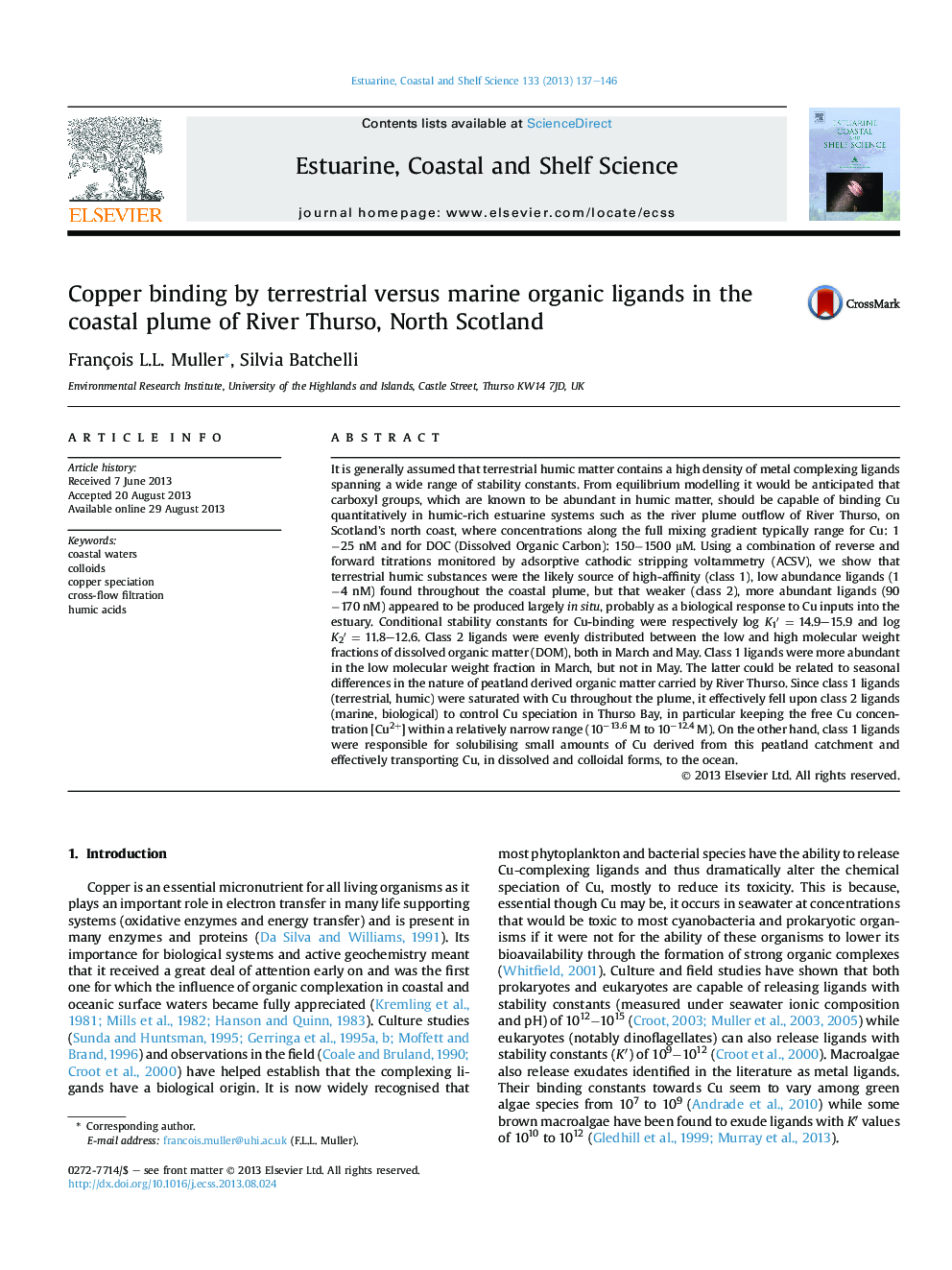| کد مقاله | کد نشریه | سال انتشار | مقاله انگلیسی | نسخه تمام متن |
|---|---|---|---|---|
| 6385034 | 1626663 | 2013 | 10 صفحه PDF | دانلود رایگان |
عنوان انگلیسی مقاله ISI
Copper binding by terrestrial versus marine organic ligands in the coastal plume of River Thurso, North Scotland
ترجمه فارسی عنوان
اتصال مسی با لیگاندهای آلی دریایی در مقابل دریایی در ساحل ساحلی تورسو، شمال اسکاتلند
دانلود مقاله + سفارش ترجمه
دانلود مقاله ISI انگلیسی
رایگان برای ایرانیان
کلمات کلیدی
آب های ساحلی، کلوئید ها، اختصاصی مس، فیلتر جریان متقاطع، اسیدهای هومیک،
موضوعات مرتبط
مهندسی و علوم پایه
علوم زمین و سیارات
زمین شناسی
چکیده انگلیسی
It is generally assumed that terrestrial humic matter contains a high density of metal complexing ligands spanning a wide range of stability constants. From equilibrium modelling it would be anticipated that carboxyl groups, which are known to be abundant in humic matter, should be capable of binding Cu quantitatively in humic-rich estuarine systems such as the river plume outflow of River Thurso, on Scotland's north coast, where concentrations along the full mixing gradient typically range for Cu: 1â25 nM and for DOC (Dissolved Organic Carbon): 150â1500 μM. Using a combination of reverse and forward titrations monitored by adsorptive cathodic stripping voltammetry (ACSV), we show that terrestrial humic substances were the likely source of high-affinity (class 1), low abundance ligands (1â4 nM) found throughout the coastal plume, but that weaker (class 2), more abundant ligands (90â170 nM) appeared to be produced largely in situ, probably as a biological response to Cu inputs into the estuary. Conditional stability constants for Cu-binding were respectively log K1â²Â = 14.9-15.9 and log K2â²Â = 11.8-12.6. Class 2 ligands were evenly distributed between the low and high molecular weight fractions of dissolved organic matter (DOM), both in March and May. Class 1 ligands were more abundant in the low molecular weight fraction in March, but not in May. The latter could be related to seasonal differences in the nature of peatland derived organic matter carried by River Thurso. Since class 1 ligands (terrestrial, humic) were saturated with Cu throughout the plume, it effectively fell upon class 2 ligands (marine, biological) to control Cu speciation in Thurso Bay, in particular keeping the free Cu concentration [Cu2+] within a relatively narrow range (10â13.6 M to 10â12.4 M). On the other hand, class 1 ligands were responsible for solubilising small amounts of Cu derived from this peatland catchment and effectively transporting Cu, in dissolved and colloidal forms, to the ocean.
ناشر
Database: Elsevier - ScienceDirect (ساینس دایرکت)
Journal: Estuarine, Coastal and Shelf Science - Volume 133, 20 November 2013, Pages 137-146
Journal: Estuarine, Coastal and Shelf Science - Volume 133, 20 November 2013, Pages 137-146
نویسندگان
François L.L. Muller, Silvia Batchelli,
